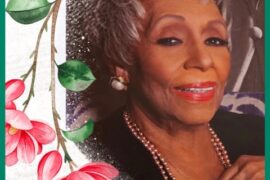The documentary “Maya Angelou:And Still I Rise,” about the life of the iconic author, makes it debut in Chicago in a short run from September 16-29 at the Gene Siskel Theater.
The film provides the richness of the 86-year visual that was the life of Maya Angelou, who died in 2014. In so doing, a portrait is presented of an African-American woman who rose from poverty to become a sustainable matriarchal American figure. Five years in the making, the film premiered at this year’s Sundance Film Festival.
Dr. Angelou has been referred to as “a redwood tree, with deep roots in American culture.” She authored seven autobiographies, three essays and a series of poetry books. Her most famous book is “I Know Why the Caged Bird Sings” and her most quoted poem is “And Still I Rise.”
The film begins with Angelou’s life in Arkansas as a small child in 1928. Her mother’s boyfriend raped her at seven years old. The trauma caused her not to speak for five years during her formative years. She lived in silence, but began writing poetry when she was nine.
Angelou’s uncles killed the man who raped her and she felt responsible; she was afraid and her child mind demanded that she not talk. She thought words could kill people.
But that silent period probably gave her the mastery of language. She learned early the power of the word, the power of speaking. She spoke with elegance, with rich description. She spoke in prose.
The documentary travels her life as a woman. She married three times. She had two interracial marriages and one brief encounter with a Ghanaian. She was a tall, stately, sexy woman who danced, acted and sang.
She traveled the world singing Calypso music and appeared in the theatrical production of “Porgy and Bess.” She lived in Africa in the early 1960s and worked with both Malcolm X and Dr. Martin Luther King Jr. She had great respect and admiration for the prolific writer James Baldwin.
About The Film
Her life’s journey for the documentary is told through her personal reflections, as she was interviewed in her living room in Winston-Salem, North Carolina. She provides perspective and historical insight and context.
Her family and friends speak to her significance and meaning and include Oprah Winfrey, her son Guy Johnson, her friend Cicely Tyson, Quincy Jones, Bill Clinton and Hillary Clinton. They all provide their personal notes.
President Bill Clinton explains why he wanted Maya to write a poem for his inauguration. He reminds us that a poet had not appeared on the inaugural stage since President John Kennedy had Robert Frost deliver one at his.
Clinton wanted Mrs. Angelou’s poem because they both came from Arkansas. Her grandmother owned a small grocery store in a little town, as did Clinton’s family. He saw the black and white commonalities and differences. He saw from whence we came to where we are.
She rose to the occasion as she recited “On The Pulse of the Morning” at Clinton’s inauguration on January 20, 1993. Her recording of that poem won her a Grammy Award in 1994.
In the film, Angelou speaks to the significant moments of life as a single mother, a divorced woman, a woman in love, a career woman and we hear her wisdom as she ages to rise to become a national treasurer.
There are scenes that I found particularly significant. She spoke about being on the set of a movie being filmed with Janet Jackson and the rapper Tupac Shakur. A racial police incident happened in Los Angeles that angered Tupac. He began using profanity about the situation, to the point of being upsetting to Mrs. Angelou as she listened to his rampage.
She pulled him aside to suggest that as an artist, he could better express his ideas more eloquently. She spoke to him about what his cursing said about him. She eventually said, now pull up your pants and stop talking like that.
Janet Jackson later visited Angelou in her trailer to tell her that she had just dressed down the very esteemed “Tupac!” Mrs. Angelou said I don’t care or know who he is, but he can better express himself. Tupac and his mother at a later date called Angelou to thank her for her wise words of challenge.
In her later years, Dr. Angelou traveled the world, speaking and reading from her books and reciting her poetry. At a Black woman’s conference, a young woman addressed her from the audience as “Maya.”
Mrs. Angelou stopped her in the dead of her question to say, you have no right, and I have not granted you permission, to call me by my first name. I am Mrs. Angelou or Dr. Angelou to you. The young lady sheepishly smiled as she bowed her head. Mrs. Angelou reminds us of another era when manners were evident and proper manners ruled respectfully.
An N’DIGO Connection

Hercules’ recent films include “Bill T. Jones: A Good Man.” His work is award winning and has been viewed in film festivals worldwide. Rita Whack produced the award winning Maya Angelou Radio Show for Oprah Radio.
The masterful cinematography is by Keith Walker, who worked on the documentary “Senator Obama Goes to Africa.” He has also shot for “60 Minutes” and has served as a cameraman for Oprah Winfrey.
This trio has produced a stellar piece on the fullness of Maya Angelou’s life. They have won awards for their work in international film festivals. This exquisite, gripping documentary will be aired as a part of Public Television’s American Masters Series in 2017.
The film is destined for an Academy Award in the category of documentary. It is beautiful and a must see for all women.





